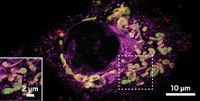Advertisement
Grab your lab coat. Let's get started
Welcome!
Welcome!
Create an account below to get 6 C&EN articles per month, receive newsletters and more - all free.
It seems this is your first time logging in online. Please enter the following information to continue.
As an ACS member you automatically get access to this site. All we need is few more details to create your reading experience.
Not you? Sign in with a different account.
Not you? Sign in with a different account.
ERROR 1
ERROR 1
ERROR 2
ERROR 2
ERROR 2
ERROR 2
ERROR 2
Password and Confirm password must match.
If you have an ACS member number, please enter it here so we can link this account to your membership. (optional)
ERROR 2
ACS values your privacy. By submitting your information, you are gaining access to C&EN and subscribing to our weekly newsletter. We use the information you provide to make your reading experience better, and we will never sell your data to third party members.
Materials
DNA Glues Particles Together
Biomaterials: Complementary DNA strands act as an adhesive to hold polymer microparticles together in 3-D-printed gels
by Jyoti Madhusoodanan
January 8, 2015

DNA base pairing can act as a smart glue to stick microparticles together to form colloidal gels. Researchers loaded a three-dimensional printer with DNA-coated particles to build soft, stable structures that could be used in tissue engineering (ACS Biomater. Sci. Eng. 2014, DOI: 10.1021/ab500026f).
DNA origami has taken advantage of the selectivity of DNA base pairing to construct nanosized and microscopic objects, such as smiley faces or maps of countries. However, these structures are usually invisible to the human eye and expensive to make. Andrew D. Ellington of the University of Texas, Austin, and his team wanted to go bigger.
They linked 2.3-μm-wide polystyrene particles to short strands of fluorescently labeled DNA then used the semisolid material to 3-D-print a pyramid a few millimeters in height underwater. When the DNA on the plastic particles is complementary, the resulting object resembles a foamy dollop. But if the strands cannot pair up, no structures form in the water.
The DNA glue strategy could allow researchers to 3-D-print structures for bioengineering because the gels form under conditions amenable to cell growth, Ellington says. In preliminary experiments, the researchers successfully grew human embryonic kidney cells within these 3-D-printed gels.
The centimeter-scale colloidal gels also serve as the “simplest, most direct demonstration” of DNA base pairing’s ability to organize larger objects, Ellington says.





Join the conversation
Contact the reporter
Submit a Letter to the Editor for publication
Engage with us on Twitter